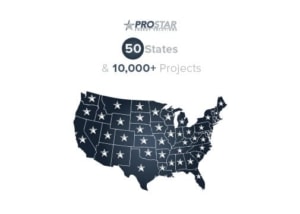Last Updated on May 22, 2022 by Mary Pressler
Net Metering for Commercial Buildings
Net metering improves the value of solar panels, ensuring that their owners get credit for all electricity generated. When homes and businesses use solar panels to generate their own kilowatt-hours, consumption from the grid decreases and the power bill drops as a result. However, there are times when solar panels generate more power than what your building is consuming, and the difference is sent to the grid. When a state has net metering laws, power companies must give you full credit for this energy, which gets subtracted from your bill.
How Net Metering Increases the ROI of Solar Panel Systems
As a quick example, let’s assume you have a commercial building that uses 300,000 kWh/year. The electricity rate is 12 cents/kWh, which leads to $36,000 in annual power bills. You decide to install a solar panel system that generates 150,000 kWh per year, but only 120,000 kWh are consumed directly and the remaining 30,000 kWh are sent to the grid.
- With net metering you get full credit for the 150,000 kWh ($18,000), regardless of how this is split between consumption and grid export.
- Without net metering you only save the full value of 120,000 kWh ($14,400) and your electricity provider decides how to manage the surplus 30,000 kWh.
In a site with favorable sunshine conditions, you can generate 150,000 kWh/year with a 100-kW solar array. Assuming a sales price of $200,000, the out-of-pocket cost becomes $148,000 thanks to the 26% Investment Tax Credit (ITC). Even lower costs are possible if there are solar rebates from your state government or local utility company, but the ITC is a nationwide benefit.
- This solar power system offers an annual ROI of 12.2% when all 150,000 kWh are deducted from your electricity bills.
- The ROI decreases to 9.7% if you only save 120,000 kWh and don’t get credit for the 30,000 kWh exported to the grid.
Which States Offer Net Energy Metering for Solar PV Systems?
Some electricity providers offer net metering even when not required by law, but others only give partial credit or no credit for surplus electricity. Here we will provide a short guide on US net metering, summarizing the conditions offered by each state. Most states require net metering by law, while others have alternative compensation rules for surplus solar energy. There are also cases where a state does not require net metering or solar buyback, but some electric companies offer the benefit voluntarily.
| Solar Net Metering Status | US States |
| Net metering required by law. | Alaska, Arkansas, Colorado, Connecticut, Delaware, Illinois, Iowa, Kansas, Kentucky, Maine, Maryland, Massachusetts, Minnesota, Missouri, Montana, Nebraska, New Hampshire, New Jersey, New Mexico, New York, North Carolina, North Dakota, Ohio, Oklahoma, Oregon, Pennsylvania, Rhode Island, South Carolina, Utah, Vermont, Virginia, Washington, West Virginia, Wisconsin, Wyoming
*Mississippi has net metering for households below 250% of the federal poverty line. |
| Net metering not required by law, but offered voluntarily by some electric companies. | Idaho, Texas |
| Distributed solar compensation rules other than net metering. | Arizona, Georgia, Hawaii, Indiana, Louisiana, Michigan, Nevada
*California and Florida have net metering programs as of March 2022, but both states could soon approve laws that will reduce the credits offered for surplus solar energy. |
| No net metering or alternative compensation. | Alabama, South Dakota, Tennessee |
Keep in mind that net metering and distributed solar programs vary by state and utility company, and this includes the maximum system capacity that is eligible for the benefit. Depending on where you live, net metering may be available for megawatt-scale solar arrays, or limited to residential and small commercial systems. The following table summarizes the system capacity limits for net metering in states that currently offer the benefit.
| State | Net Metering Limit |
| Alaska | 25 kW |
| Arkansas | 25 kW residential, 300 kW commercial |
| Colorado | 120% of average annual consumption (Investor-Owned Utilities)
10 kW residential, 25 kW non-residential (Municipal and Cooperatives) |
| Connecticut | 2 MW standard net metering, 3 MW virtual net metering |
| Delaware | 2 MW nonresidential Delmarva customers
500 kW nonresidential cooperative and municipal utility customers 25 kW residential customers 100 kW farm customers |
| Illinois | 2 MW |
| Iowa | 1 MW |
| Kansas | 100 kW nonresidential, 15 kW residential, 150 kW schools |
| Kentucky | 45 kW |
| Maine | 660 kW for investor-owned utility customers
100 kW for cooperative and municipal utility customers |
| Maryland | 200% of baseline consumer electricity usage, up to 2 MW |
| Massachusetts | 2 MW for investor-owned utility customers
10 MW for cooperative and municipal utility customers |
| Minnesota | 1 MW |
| Missouri | 100 kW |
| Montana | 50 kW |
| Nebraska | 25 kW |
| New Hampshire | 1 MW |
| New Jersey | 100% of customer electricity usage. |
| New Mexico | 80 MW |
| New York | 25 kW residential, 100 kW farms, 2 MW nonresidential |
| North Carolina | 1 MW for customer-owned solar PV systems
100% of estimated demand up to 20 kW for leased residential systems 100% of contract demand up to 1,000 kW for leased nonresidential |
| North Dakota | 100 kW |
| Ohio | 100% of customer electricity usage. |
| Oklahoma | 300 kW |
| Oregon | 25 kW residential customers
25 kW all cooperative, municipal utility and PUD customers 2 MW nonresidential PGE and PacifiCorp customers |
| Pennsylvania | 50 kW residential, 3 MW nonresidential
5 MW microgrid and emergency systems |
| Rhode Island | 100% of customer electricity usage up to 10 MW |
| South Carolina | 20 kW residential, 1,000 kW nonresidential |
| Utah | 25 kW residential, 2 MW nonresidential |
| Vermont | 500 kW |
| Virginia | 20 kW residential, 500 kW farms, 1,000 kW other nonresidential |
| Washington | 100 kW |
| West Virginia | -25 kW residential
-50 kW commercial and industrial (investor-owned utilities with less than 30,000 customers, cooperatives and municipal utilities). -500 kW commercial, 2 MW industrial (investor-owned utilities with more than 30,000 customers). |
| Wisconsin | 20 kW |
| Wyoming | 25 kW |
SOURCE: Database of State Incentives for Renewables & Efficiency® – DSIRE (dsireusa.org)
National and Local Incentives for Solar Power: Potential Savings
The Investment Tax Credit, also known as the federal tax credit, is the only nationwide incentive for solar power in the US. However, commercial solar installations can also benefit from the Modified Accelerated Cost Recovery System (MACRS).
- Good quality solar panels normally last for more than 25 years.
- However, commercial users can write off the asset value of a solar panel system in just five years. This depreciation is tax deductible.
Solar rebates and other incentives may be available depending on your state and utility company. There are many solar programs in the US, but the following are some of the largest as of 2022:
| Solar Incentive Program | Location |
| Solar Massachusetts Renewable Target (SMART) | Massachusetts |
| Duke Energy Solar Rebate Program | North Carolina |
| NY-Sun Initiative – Megawatt Block Program | New York |
| Oncor Solar Photovoltaic Standard Offer Program | Texas |
Solar incentives are the ideal complement for net metering, and you can get a quick payback period when both benefits are available. While incentive programs reduce the ownership cost of solar panels, net metering increases the savings achieved by their electricity output. With favorable sunlight conditions and local incentives, a commercial solar array can achieve a payback period of less than 6 years, which is great for an asset that lasts more than 25 years.
NOTE: The goal of this article is being informative, and we don’t intend to give tax advice. We recommend getting in touch with a Certified Public Accountant (CPA) to make sure all the tax benefits of your solar power system are deducted correctly.
 Commercial Solar Design and Installation
Commercial Solar Design and Installation
For help regarding new solar projects, we recommend Pro Star Energy. Pro Star designs, installs and manages commercial solar power systems in all US states, including Canada. No job is too big or too small for this Texas owned solar company. Let Pro Star manage your solar PV installation project from start to finish. Reach out today.


